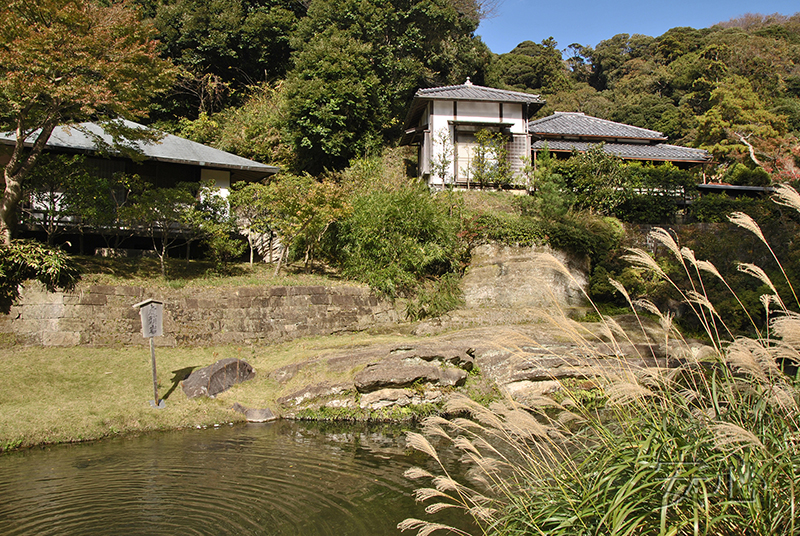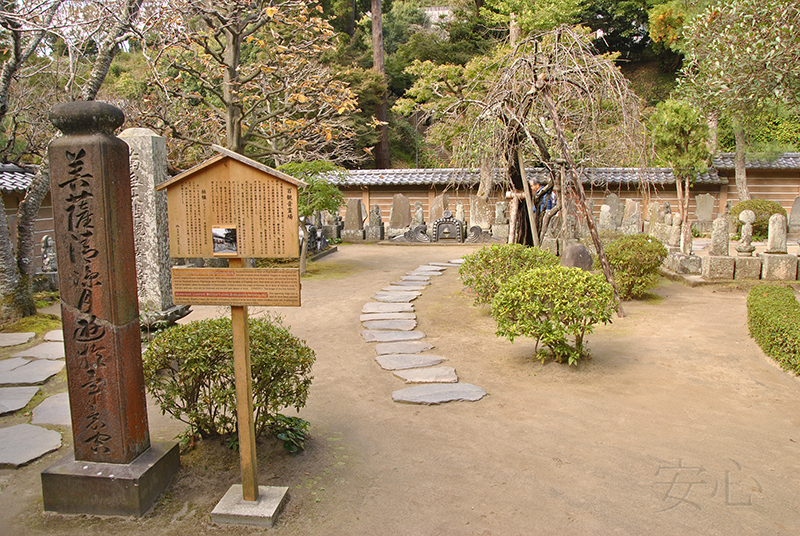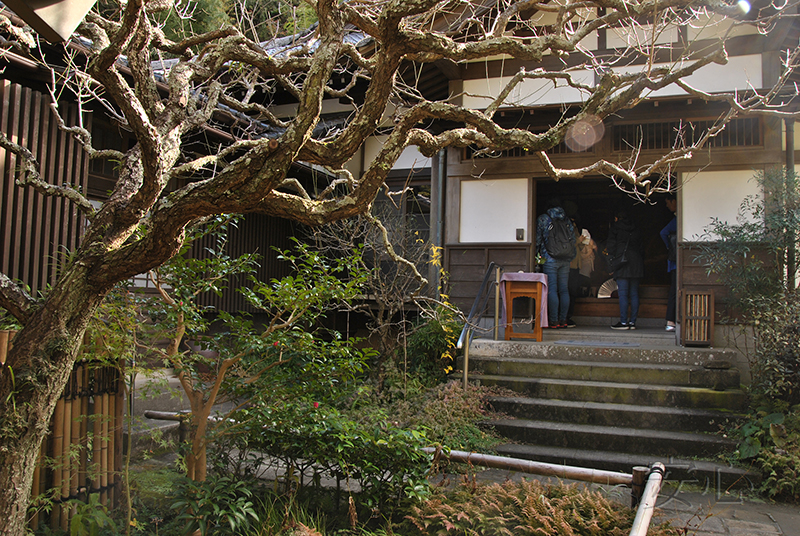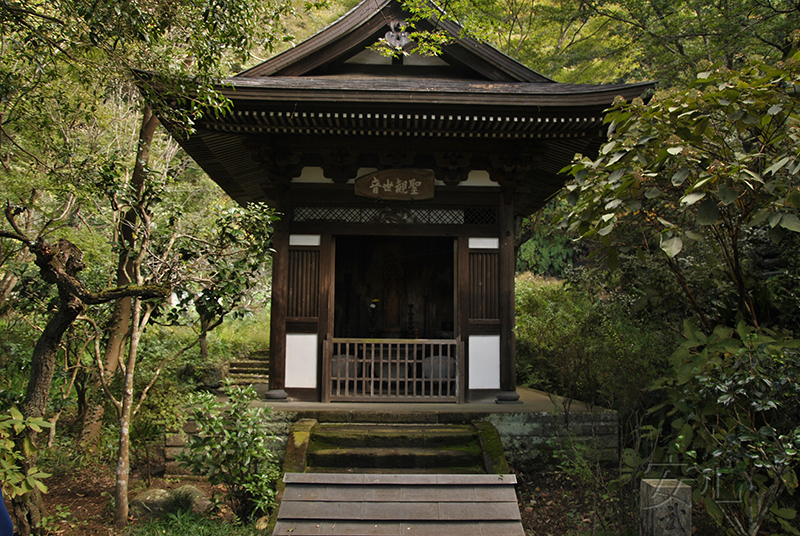
The gardens of Engaku-ji Temple, Kamakura
Engaku-ji Temple was founded in 1282 for the repose of the souls of those who had died in the battles between Japan and the Mongol or Yuan dynasty of China in 1274 and 1281. Despite the hatred for the Mongols invading northern Kyushu, the souls of the dead enemies also received due respect in this temple.
The name of the temple was due to the fact that during the construction a container was unearthed that held a scripture of the Engaku-kyo Sutra.
The founding priest of Engakuji was Mugaku Sogen (or Bukko Kokushi), invited from China. A well-known case was connected with his name: when he was in China, the Yuan forces advanced into the area where Sogen had taken refuge in a temple called Noninji.
When the rebel troops reached the area where Sogen took refuge and burst into the temple, the monk was not afraid, but calmly composed a four-line poem. In it, he expressed regret that the world had become so small, and there was no room for temple attendants, and both the law and humans are simple nothingness. The soldiers, it is said, withdrew in admiration.The temple experienced periods of ups and downs. Even after 1333 and the downfall of the Hojo who had supported the temple, Engakuji was able to maintain its prosperity under Muso Soseki . He designed the wonderful Myokochi pond. However, then, successive fires , almost consumed the temple and it fell into decline from the Muromachi period through the Edo period. In 1875, the high priest Imakita Kosen restored Engaku-ji to the status of one of the leading Zen training institutions in the Kanto region.
Once the territory of the temple was much larger, and reached the road behind the Kita-Kamakura Station. The formal approach is via Gomabashi Bridge (Evil-Subduing Bridge) through the Byakurochi Pond ("White Egret Pond"). There is a legend that a deity in the form of a white egret (or byakuro) led Mugaku Sogen to the pond, and that is why he gave to it such a name. Unfortunately, the construction of the Yokosuka line in 1889 significantly reduced the pond.
Beyond the pond and the Yokosuka Line tracks is a stone steps leading up to the Somon Gate.
Behind the gate, the climb continues. Another stone staircase leads to the massive two-story Sammon Gate, whose roof is covered with copper.
The main hall of Butsuden has inside a seated statue of Hokan Shaka Nyorai in a crown decorated with precious stones. It was made at the end of the Kamakura period. Butsuden Hall was destroyed during the 1923 earthquake, then it was rebuilt, but this time the hall was constructed of reinforced concrete. Nevertheless, the design is an exact copy of the original 1573.
To the left of Butsuden is the meditation hall and the sutra repository of the Sembutsudo hall.
Nearby there is another room for meditation and training, Kojirin. On the day of our visit, it was closed.
Particular interest to us is the Miokochi pond. Its name literally means "Pond of Sacred Fragrances." It was made by Muso Kokushi.
Remodeled in 2001, the Myokochi Pond was declared Place of Scenic Beauty by the government.
On the opposite bank there is a large Kotogan, or “Tiger Head” Rock. It is difficult to understand exactly where you can see a tiger. Perhaps the striped structure of the stone evokes thoughts of resemblance to this animal. A building on the stone is the residence of the priest.
Opposite the Miokochi Pond there is another pond. It is located in the courtyard of the Hojo Hall. The character is pronounced shin or kokoro (meaning heart), and a pond of this shape is called shinji-ike, "shin-character pond".
The garden is enclosed between two buildings, standing at right angles to each other, and a hill.
The shore near the house is covered with light pebbles, combed in the form of calm waves.
The stones in the pond are perfectly matched. It seems that they just broke away from the cliff.
A wooden gate opposite Hojo leads into the courtyard. A large tree opposite the gate is said to have been planted by Mugaku Sogen, the founder of Engaku-ji. Thus, it is already about seven hundred years old.
Hundred Kannon in front of Hojo began when Sesso enshrined hundred stone Buddhist images in carves and Zen priest, Imakita Kosen maintained them. With these hundred Kannon as the final place to pray, the sacred places to visit for Hundred Kannon Pilgrimage were founded in the temples of Engakuji sect.
And behind this closed gate is Shariden, where Buddha's tooth worshiped as "Butsuge Shari" is enshrined. The building was damaged during a fire in the 16th century, after that the Butsuden building from the Taihei-ji monastery was moved to this place. It was also destroyed during the earthquake, but restored in 1929. Shariden is opened to the public only a few times a year: on New Year's holiday, Golden Week in May and Homotsu Kazeire in November.
On the territory of Engaku-ji there is also a tea house with a classic tea garden. Unfortunately it was also closed and we could only take pictures through the fence.
At the far end, next to Butsunichian, is Biyakurokudo (White Deer Cave). According to legend, on the Engaku-ji’s opening day, when Sogen was giving his first sermon, a herd of white deer suddenly appeared and listened to priest. This was thought to be a good omen and now there is a small cave dedicated to white deer.
Butsunichian is the mausoleum of Hojo Tokimune, the eighth regent, later served as the mausoleum of the head family, tokuso, of the Hojo. The main hall, built in the Edo era, has three wooden statues clad in priests and an eleven-faced statue of Cannon. Within the courtyard are two other structures: Insokuken and Fukoan. A tea ceremony is held on the fourth day of every month to commemorate the day Tokimune died.
Behind Butsunichian, at the end of the road by the hill, is Obain. The stupa was built for Muso Soseki by his apprentice, Hogai Koen. There is a statue of the priest inside, as well as a statue of Kannon, brought from China.
On the territory of Engaku-ji temple there is a Ogane bell, which is a national treasure of the country. Its height is 2.6 meters, it is the largest bell in the Kanto region. Ogane was casted in 1301. Hojo Tokimune’s son, Sadatoki, one night in his dream, he was told to dig up the bottom of Engakuji’s Biyakurochi (White Heron Pond). When he did as told, he found gold-plated copper in the shape of dragon’s head, which was told to be used to cast the Ogane. It was used to create the Ohane bell.
True, we did not reach the bell itself, we only took a picture of the stairs leading to it.
We came to Engaku-ji, as we were interested in the Miokochi pond and the garden opposite Hojo. However, the territory of the temple is very large, and we found many other interesting gardens and beautiful places, some of them are practically not mentioned on the Internet. For example, a tea garden. And also a small bamboo grove and a temple building hidden in it from the eyes of strangers. I don’t know what kind of building it is, possibly a living rooms. But suddenly I imagined how fantastic it would be to come out onto such a porch early in the morning and to listen to the sound of swaying bamboo ...
Garden Information:
Address: 409 Yamanouchi, Kamakura city, 247-0062, JAPAN
Opening hours: from 8 a.m. to 4 p.m.
anshin©2011All rights reserved. When using the materials of the site, reference is obligatory.
Proposals for co-operation, as well as comments and suggestions on the site please send to the address: anshinsad@gmail.comtel: +7 (965) 121-80-60, 10am-20pm































